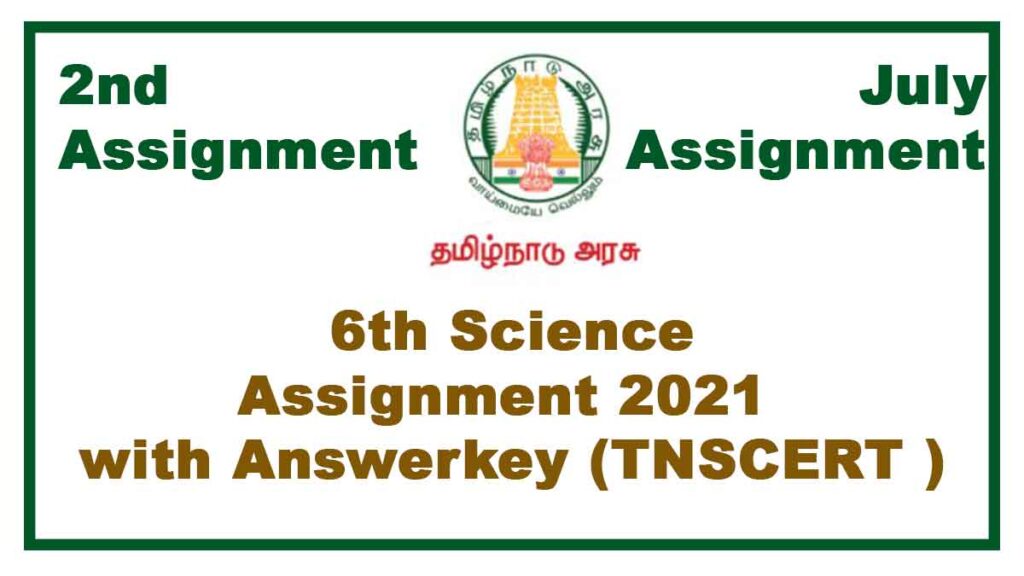6th Science 2nd Assignment July 2021(With Answers) Tamilnadu Stateboard This the second assignment for Tamilnadu stateboard school students. students must submit the assignment with answers on time. This is the very important instruction given by the school education department. To help tn school students we prepared and shared the most accurate answers here. You can download it by using the direct link in PDF format

6th Science Tamil Medium 2nd Assignment July 2021(With Answers)
- Download 6th Science TM second assignment pdf only questions – Download Now
- Download 6th Science TM second assignment pdf with answers only questions – Visit This Page
6th Science English Medium 2nd Assignment July 2021(With Answers)
- Download 6th Science EM second assignment pdf only questions – Download Now
- Download 6th Science EM second assignment pdf with answers only questions – Visit This Page
Assignment
Class: 6 Subject: Science
Unit-2 Forces and Motion
Part – A
I.One Mark Questions.
When there is a change of position of an object with respect to time, then it is called
a. motion
b. rest
c. work
d.force
Answer :- a. motion
When there is no change of position of an object with respect to time, then it is called
a. motion
b. rest
c. work
d.force
Answer :- b. rest
What is called as the distance travelled by an object in unit time?
a. speed
b. average speed of the object
c. motion
d. force
Answer :- a. speed
IIf an object covers uniform distances in uniform intervals, then the motion of the object is called……….
a. uniform motion
b. Non Uniform Motion
c. speed
d. average speed of the object
Answer :- a. uniform motion
5.If an object covers non-uniform distances in non-uniform intervals then the motion of the object is called_____
a. Non Uniform Motion
b. Uniform Motion
c. speed
d. average speed of the object
Answer :- a. Non Uniform Motion
Unit of speed is_______.
a.mm/s
b.cm/s
c.km/s
d. m/s
Answer :- d. m/s
Oscillatory motion among the following is
a. Rotation of the earth about its axis
b. Revolution of the moon about the earth
c. To and fro movement of a vibrating string
d. All of these.
Answer :- c. To and fro movement of a vibrating string
The correct relation among the following is
a. Speed = distance × time
b. Speed = distance / time.
c. Speed = time / distance
d. Speed = 1 / (distance × time)
Answer :- b. Speed = distance / time.
Average speed is calculated by
a. distance travelled / time taken (s= d/t)
b. time taken / distance travelled (s= t / d)
c. distance travelled time taken (s= dt)
d. time taken * distance travelled (s= t * d)
Answer :- a. distance travelled / time taken (s= d/t)
The distance travelled is calculated by
a . speed × time.
b. time× speed
c. digital clock
d. atomic clock
Answer :- a . speed × time.
Part – B
II. Short Answer.
Define force.
Forces are push or pull by an animate or inanimate agency
Name different types of motion based on the path.
- Linear motion;
- Curvilinear;
- Circular motion;
- Rotatory motion;
- Oscillatory motion
- Irregular motion.
If you are sitting in a moving car, will you be at rest or motion with respect your friend sitting next to you?
I am in rest with respect to my friend, sitting inside the car.
Rotation of the earth is a periodic motion. Justify.
Rotation of the earth is a periodic motion because it takes equal interval of time for all rotations.
Differentiate between rotational and curvilinear motion.
Rotational motion:
- A body moves along a circular path.
- Without changing its position, about its own (fixed) axis.
- Eg. Rotation of a spinning top.
Curvilinear motion:
- A body moves along a curved path.
- Changes its position with motion.
- Eg. Throwing paper airplanes or paper darts.
Part – C
III.Write in detail.
What is motion? Classify different types of motion with examples
Motion is a change in the position of an object with respect to time.
Types of motion based on the path:
- Linear motion: moving in a straight line, like a person walking on a straight path.
- Curvilinear motion: moving ahead by changing direction like a throwing ball.
- Circular motion: moving in a circular path. Ex. Swirling store tied to the rope.
- Rotatory motion: The movement of a body about its own axis. Ex. Revolution of the earth around the sun.
- Oscillatory motion: Coming back to the same position after a fixed time interval. Ex pendulum.
- Zigzag (irregular): like the motion of a bee or people walking in a crowded street.
Part– D
IV.Activity
Identify the type of motion in the following pictures
a. The movement of cradle.

It strikes the stationary spheres, transmitting a force through the stationary spheres that pushes the last sphere upward
b.A moving train

Train moving on a track follows a straight line,hence it undergoes linear motion.
C. A flying bird

A flying bird around the sky is a combination of all motion and the flight path is zigzag
Unit-5 THE LIVING WORLD OF ANIMALS
Part- A
I. One Mark Questions:
Dwelling pink of an organism is known as?
a ecosystem
b. habitat
c. house
d. rivers
Answer :- b. habitat
Whicc of th following s multicellular organism?
a. Amoeba
b. Euglena
c. bird
d. Paramecium
Answer :- c. bird
Gills in fish helps to observe?
a. carbon dioxide
b. hydrogen
c. hydrogen and oxygen
d. oxygen
Answer :- d. oxygen
Which living being can see one object with one eye and the other object with other eye?
a. lizards
b. Birds
c. human beings
d. Ants
Answer :- b. Birds
Camel’s hump has fat for?
a. cooling of the body
b. feeding young Camels
c. own nourishment
d. protecting skin
Answer :- c. own nourishment
Minimum resistance to air in birds is provided by__________
a. wings
b. streamlined body
c. light bones
d. beaks
Answer :- a. wings
Unicellular Organisms have
a. tissues
b. organs
c. organ system
d. none of the above
Answer :- d. none of the above
8.Living things are made up of small units called?
a. tissues
b. bones
c. cells
d. fibers
Answer :- c. cells
9.Unicellular organisms perform all the year physiological activities by
a. tissues
b. organelles
c. organ system
d. none of the above
Answer :- b. organelles
Division of labour exists among cells in
a. unicellular organisms
b. only in human beings
c. unicellular and multi cellular organisms
d. multi cellularm organisms
Answer :- d. multi cellularm organisms
P rt – B
II. Very Shor An we
Define bio-diversity?
In the living world, a lot of diversity is seen both in animals and plants, Every plant and animal is unique. It is called biodiversity
Write any two examples for Unicellular Organism?
- Amoeba
- Paramecium
- euglena
Write any four differences between unicellular and multi cellular organisms?
| Unicellular | Multicellular |
| They are made up of a single cell | They are organisms that are made up many cells |
| They can perform all the functions of life | Division of labour exists among cells |
| These organisms are generally very small in size | They are mostly large in size |
| Growth occurs by an increase in the size of the cells | Growth occurs by an increase in the number of cells by cell divisiion |
| Eg, Amoeba, Paramecium | Eg, Fish, Frog |
Write any two adaptations of Lizard?
Some lizard have the capacity to rotate the head around the head joint,they breath through lungs
What is the ship of the desert?
Camel is called ship of the desert
Part- C
III. Write in Detail
Explain about animal adaptations?
All living thing can survise in a particular habit if its body is adapted to the conditions of that habitat.plants and animals develop special characteristics or features in their body in order to survive in their habitat. The presence of specific body features for certain habits which enable a plant or an animal to live in a particular habitat is called animal adaptation
Part D
IV.Activity
Do you walk easily on soft, hot sand? How camels walk easily on Soft sand?
- The long leg of camel helps to keep its body away from the desert
- Camel will drink large amount of water and store it in the body
- camel produce only small quantity of urine
- the stored fat in the hump can be break down for nourishment
- It can keep its hostrils closed to avoid dust

1 COMMENTS
Comments are closed.